Cooling Effect of Phase Change Materials Applied in Undergarments of Mine Rescuers in Simulated Utility Conditions on Thermal Manikin
Abstract
:1. Introduction
2. Materials and Methods
2.1. Tested Object
2.1.1. Phase Change Materials
2.1.2. Protective Undergarments with PCM
2.1.3. Protective Clothing for Mine Rescuers
2.2. Research Equipment
2.2.1. Newton-Type Thermal Manikin
2.2.2. Climatic Chamber
2.2.3. Microclimatic Meter
2.2.4. Thermal Imaging Cameras
2.3. Methodology
3. Results
3.1. Results of Heat Flux Density
3.1.1. Heat Flux Density for Undergarments A (Variants I and II)
- ΔHci_T-shirt(0–20): change in the average density of heat flux caused by the T-shirt, for 20 min from the moment of application of the T-shirt, compared to the average Hc value from 20 min application of the T-shirt (from pre-test at stabilization state) (variant I), W/m2;
- ΔHci_cool(0–20): difference in heat flux density changes between the variant with active cooling (variant II) and the variant without active cooling (variant I), W/m2.
3.1.2. Heat Flux Density for Undergarments (Type A) with Outerwear (Variants III and IV)
- ΔHci_T-shirt(0–20): change in the average density of heat flux caused by the T-shirt, 20 min from the moment of application of the T-shirt, compared to the average Hc value from 20 min before application of the T-shirt (from pre-test at stabilization state) (variant III), W/m2;
- ΔHci_cool(0–20): difference in heat flux density changes between the variant with active cooling (variant IV) and the variant without active cooling (variant III), W/m2.
3.2. Illustrative Photos Taken by Thermal Imaging Cameras
3.2.1. Thermograms of the Undershirt (Variants I and II)
3.2.2. Thermograms of the Outerwear (Variants III and IV)
4. Discussion and Conclusions
Author Contributions
Funding
Institutional Review Board Statement
Informed Consent Statement
Data Availability Statement
Acknowledgments
Conflicts of Interest
References
- Drenda, J. Ocena klimatycznych warunków pracy górników w polskich kopalniach węgla kamiennego i rudy miedzi. [Rating of climatic working conditions of miners in Polish coal mines and copper ore]. Górnictwo Geol. 2012, 7, 19–35. [Google Scholar]
- Bugajska, J.; Sobolewski, A.; Marszałek, A.; Bagiński, M.; Syty, J. Bezpieczeństwo Ratowników Górniczych w Czasie akcji w Trudnych Warunkach Klimatu w Kopalniach Węgla Kamiennego—Obciążenie Cieplne. [Safety of Mine Rescuers in Action in the Difficult Climate Conditions in coal Mines—The Thermal Load]. In Bezpieczeństwo Zdrowia Publicznego w Zagrożeniach Środowiskowych. Postępy Metodologii Badań; Konieczny, J., Ed.; Poznań—Łódź—Inowrocław: Inowrocław, Poland, 2012. [Google Scholar]
- Szlązak, N.; Obracaj, D.; Głuch, B. Analiza warunków mikroklimatu w rejonie ścian eksploatacyjnych kopalń węgla kamiennego. Górnictwo I Geol. 2013, 2, 99–113. [Google Scholar]
- Kalkowsky, B.; Kampmann, B. Physiological strain of miners at hot working places in German coal mines. Ind. Health 2006, 44, 465–473. [Google Scholar] [CrossRef] [PubMed] [Green Version]
- Zwolińska, M.; Bogdan, A. Impact of the medical clothing on the thermal stress of surgeons. Appl. Ergon. 2012, 43, 1096–1104. [Google Scholar] [CrossRef] [PubMed]
- Gao, C.; Kuklane, K.; Holmer, I. Effects of temperature gradient on cooling effectiveness of PCM vests in an extremely hot climate. In Proceedings of the 13th International Conference on Environmental Ergonomics, Boston, MA, USA, 2–7 August 2009. [Google Scholar]
- Bartkowiak, G.; Dąbrowska, A.; Marszałek, A. Analysis of thermoregulation properties of PCM garments on the basis of ergonomic tests. Text. Res. J. 2013, 83, 148–159. [Google Scholar] [CrossRef]
- Yan, Y.; Li, W.; Zhu, R.; Lin, C.; Hufenus, R. Flexible Phase Change Material Fiber: A Simple Route to Thermal Energy Control Textiles. Materials 2021, 14, 401. [Google Scholar] [CrossRef] [PubMed]
- Teunissen, L.; Janssen, E.; Schootstra, J.; Plaude, L.; Jansen, K. Evaluation of Phase Change Materials for Personal Cooling Applications. Cloth. Text. Res. J. 2021. [Google Scholar] [CrossRef]
- Tjønnås, M.; Færevik, H.; Sandsund, M.; Reinertsen, R. The dry heat loss effect of melt spun phase change material fiber garments on a thermal manikin February 2013 Conference. In Proceedings of the 15th International Conference of Environmental Ergonomics, Queenstown, New Zealand, 11–15 February 2013. [Google Scholar]
- Gao, C.; Kuklane, K.; Wang, F.; Holmer, I. Personal cooling with phase change materials to improve thermal comfort from a heat wave perspective. Indoor Air. 2012, 22, 523–530. [Google Scholar] [CrossRef] [PubMed]
- Regulation (EU) 2016/425 of the European Parliament and of the Council of 9 March 2016 on Personal Protective Equipment and Repealing Council Directive 89/686/EEC; EU: Brussels, Belgium, 2016.
- EN ISO 11612:2015; Protective Clothing—Clothing to Protect against Heat and Flame—Minimum Performance Requirements. CEN: Brussels, Belgium, 2015.
- EN 1149-5:2018; Protective Clothing—Electrostatic Properties—Part 5: Material Performance and Design Requirements. CEN: Brussels, Belgium, 2018.
- Donoghue, A.M.; Sinclar, M.J.; Bates, G.P. Heat exhaustion in deep underground metalliferous mine. Occup. Environ. Med. 2000, 57, 165–174. [Google Scholar] [CrossRef] [PubMed]
- Mondal, S. Phase change materials for smart textiles—An overview. Appl. Therm. Eng. 2008, 28, 1536–1550. [Google Scholar] [CrossRef]
- Schultz, J. Advanced Storage Concepts: Phase Change Materials, the International Energy Agency—The Solar Heating and Cooling Programmes (IEA SHC), Task 32 C; Schultz, J., Andersen, E., Furbo, S., Eds.; Technical University of Denmark: Kgs. Lyngby, Denmark, 2008; pp. 1–16. [Google Scholar]
- Młynarczyk, M.; Havenith, G.; Léonard, J.; Martins, R.; Hodder, S. Inter-laboratory proficiency tests in measuring thermal insulation and evaporative resistance of clothing using the Newton-type thermal manikin. Text. Res. J. 2018, 88, 453–466. [Google Scholar] [CrossRef] [Green Version]
- Młynarczyk, M. Characteristics of Specialised Firefighter Clothing Used in Poland—The Thermal Parameters. Fibres Text. East. Eur. 2020, 139, 65–70. [Google Scholar] [CrossRef]
- Młynarczyk, M. Influence of Air Velocity on the Total Thermal Insulation of Different Types of Clothing. Fibres Text. East. Eur. 2019, 138, 75–80. [Google Scholar] [CrossRef]
- Bartkowiak, G.; Marszałek, A.; Dąbrowska, A. Thermal Load of Mine Rescuer in the Underwear and Protective Clothing with Phase Change Materials in Simulated Utility Conditions. Materials 2020, 13, 4320. [Google Scholar] [CrossRef]
- Marszałek, A.; Bartkowiak, G.; Dąbrowska, A.; Krzemińska, S.; Łężak, K.; Makowski, K.; Bugajska, J. Mine Rescuers’ Heat Load during the Expenditure of Physical Effort in a Hot Environment, Using Ventilated Underwear and Selected Breathing Apparatus. Int. J. Occup. Saf. Ergon. 2017, 24, 1–13. [Google Scholar] [CrossRef] [PubMed] [Green Version]

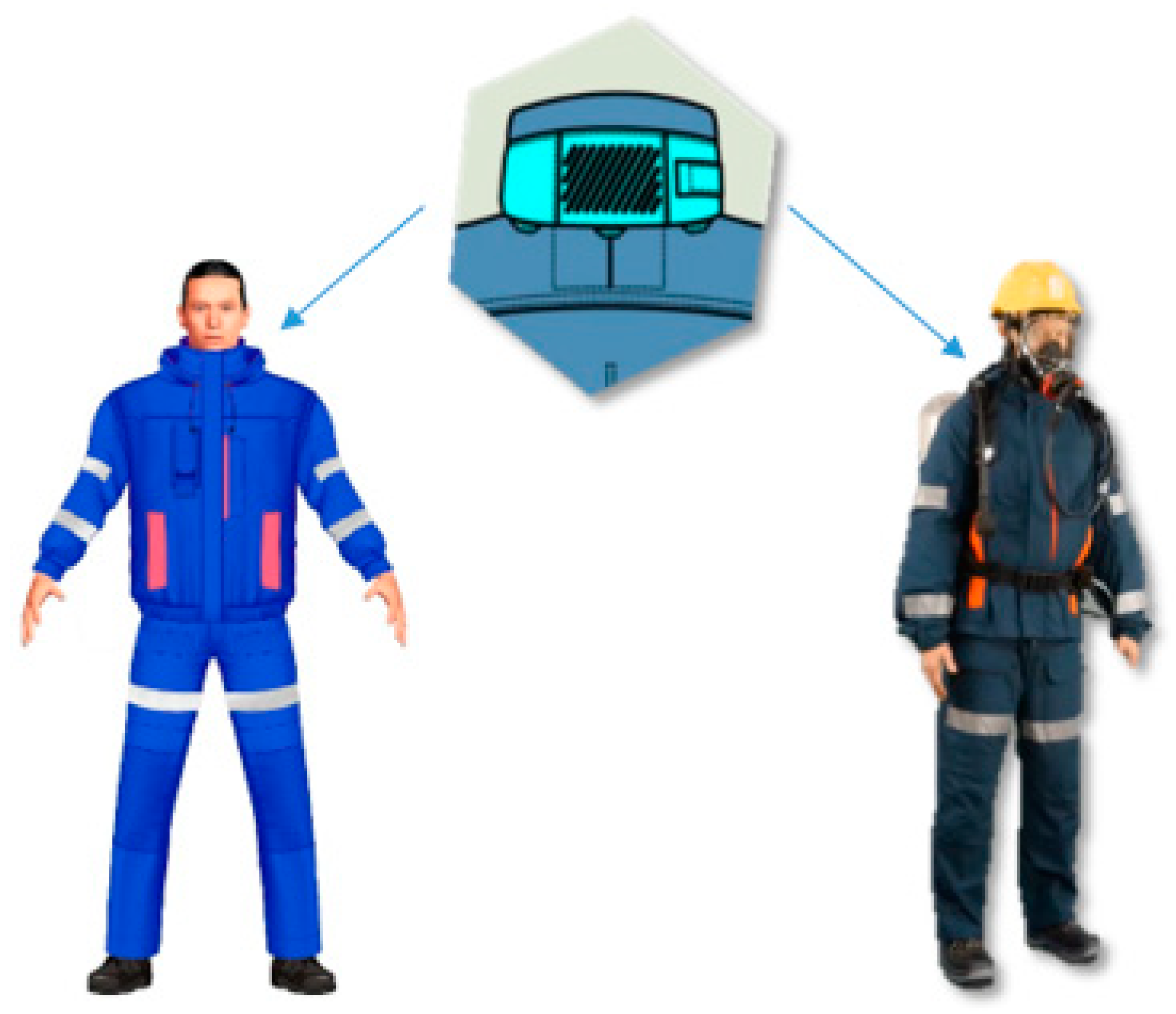
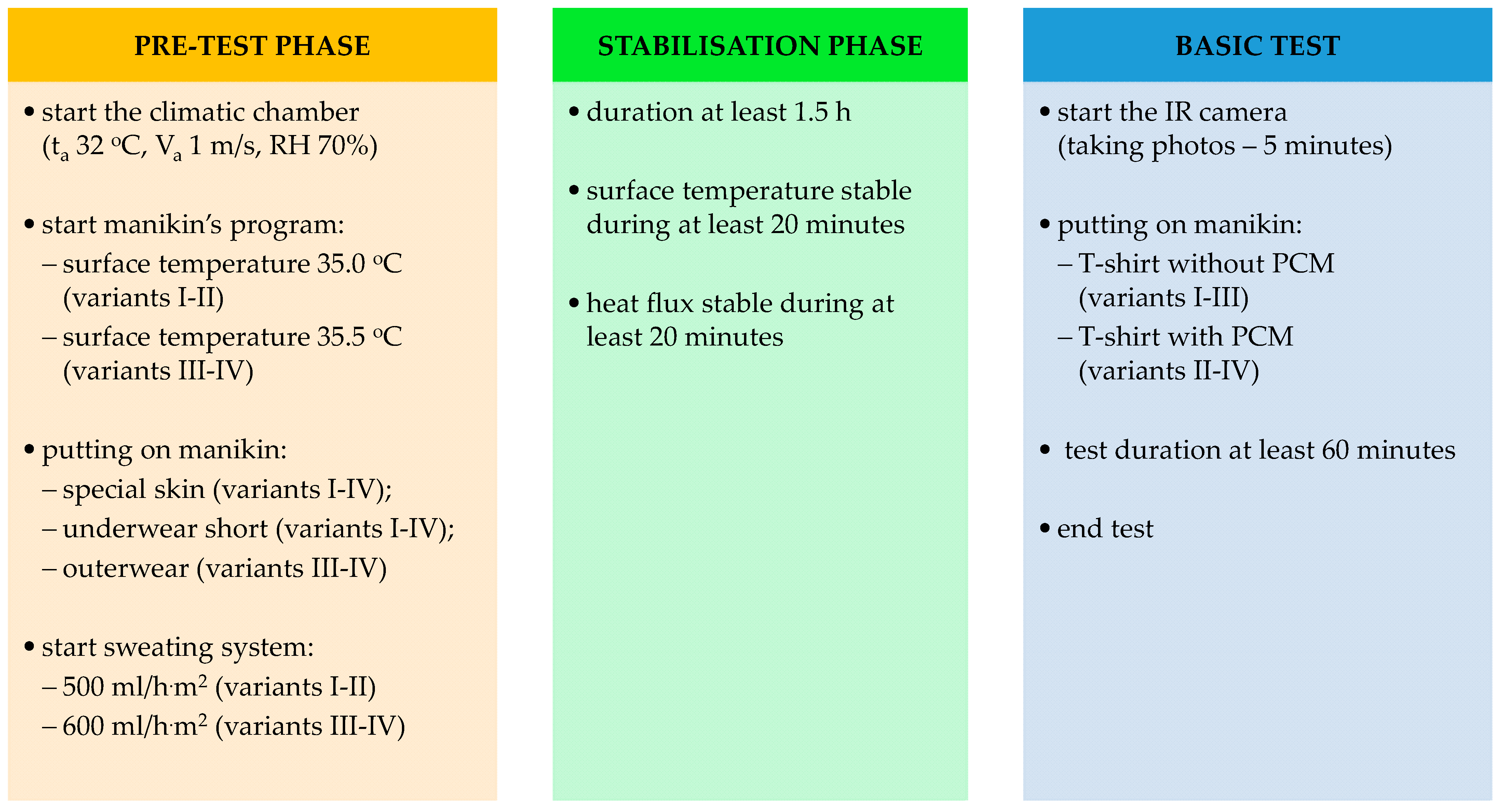
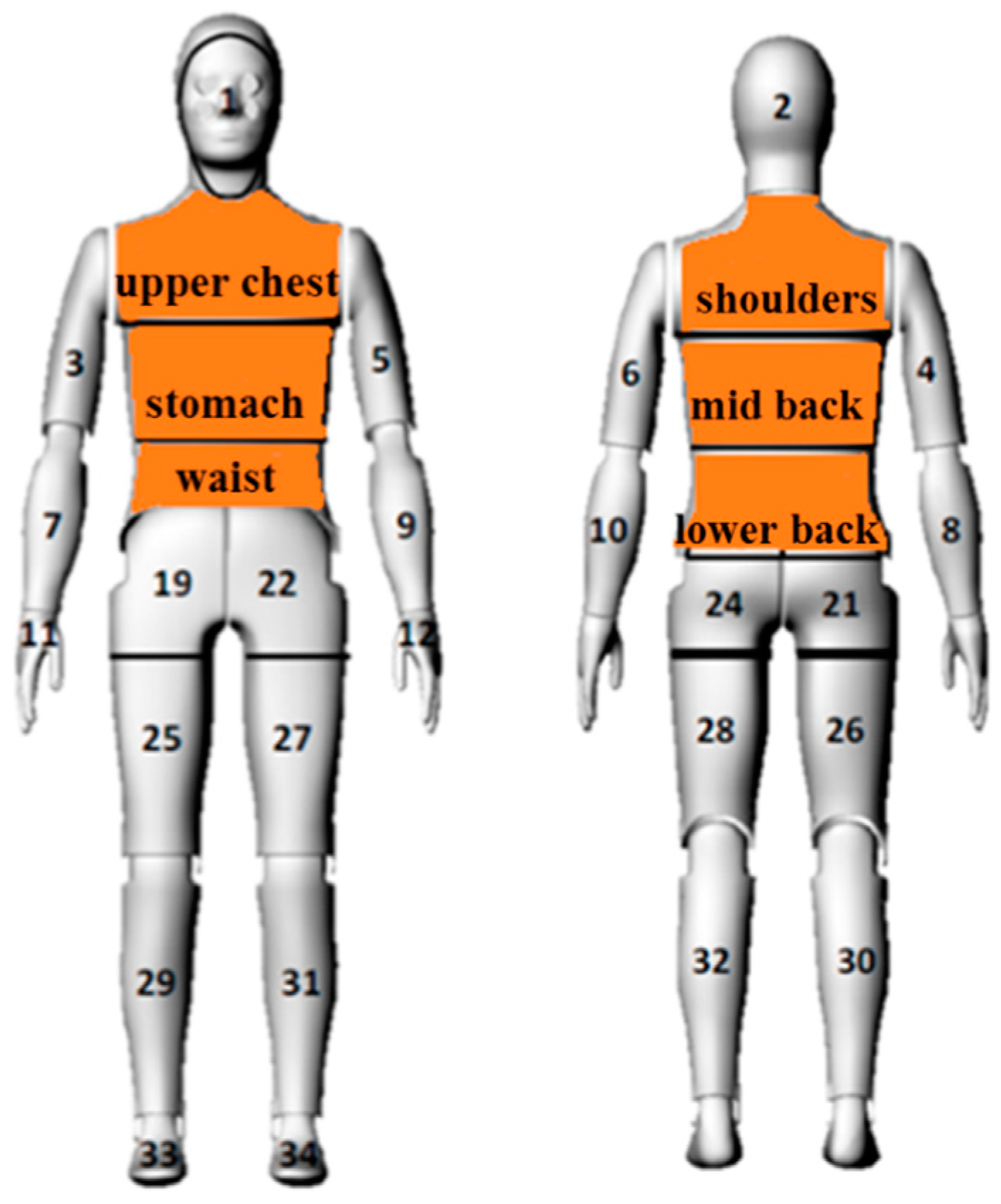

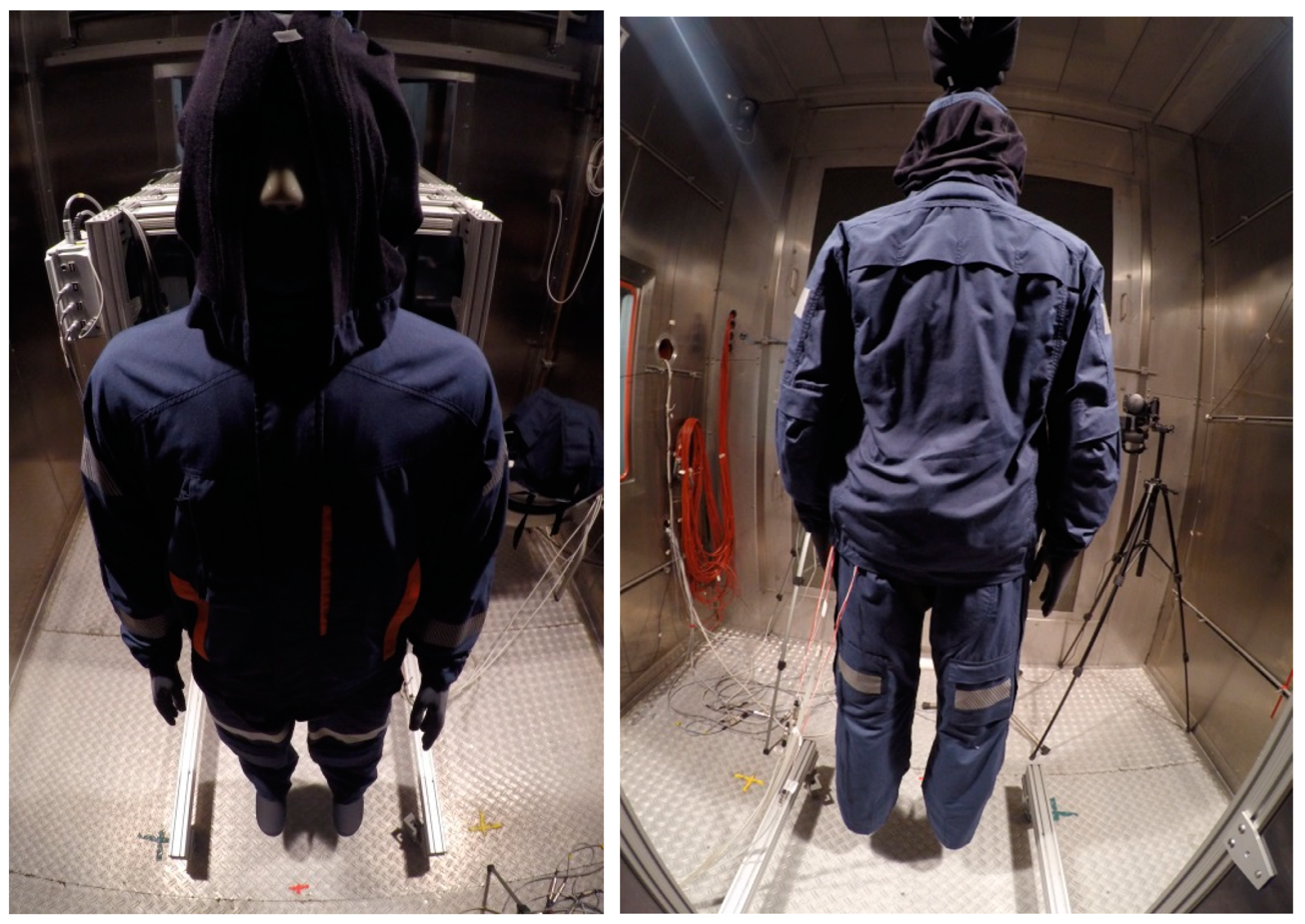
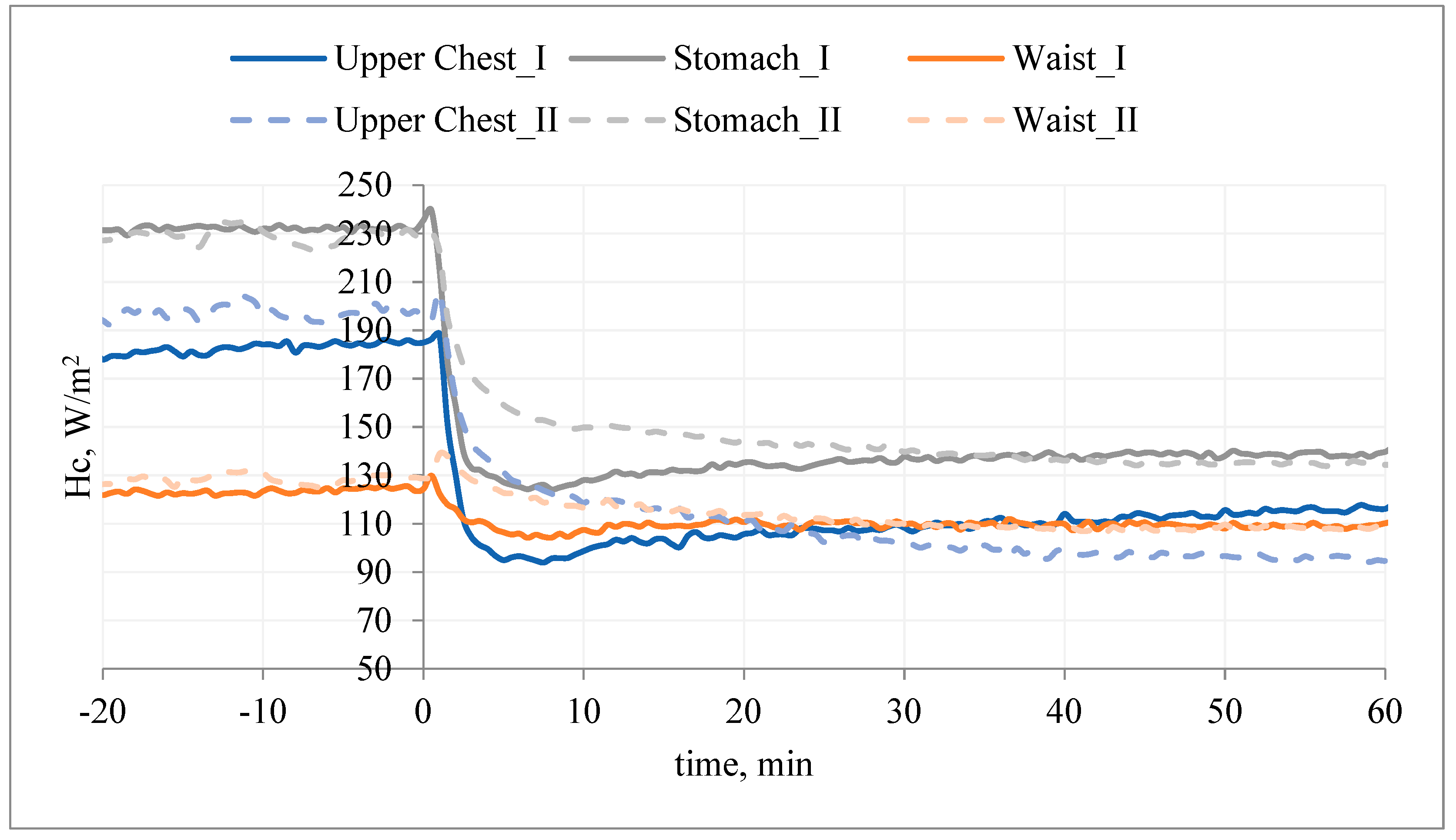
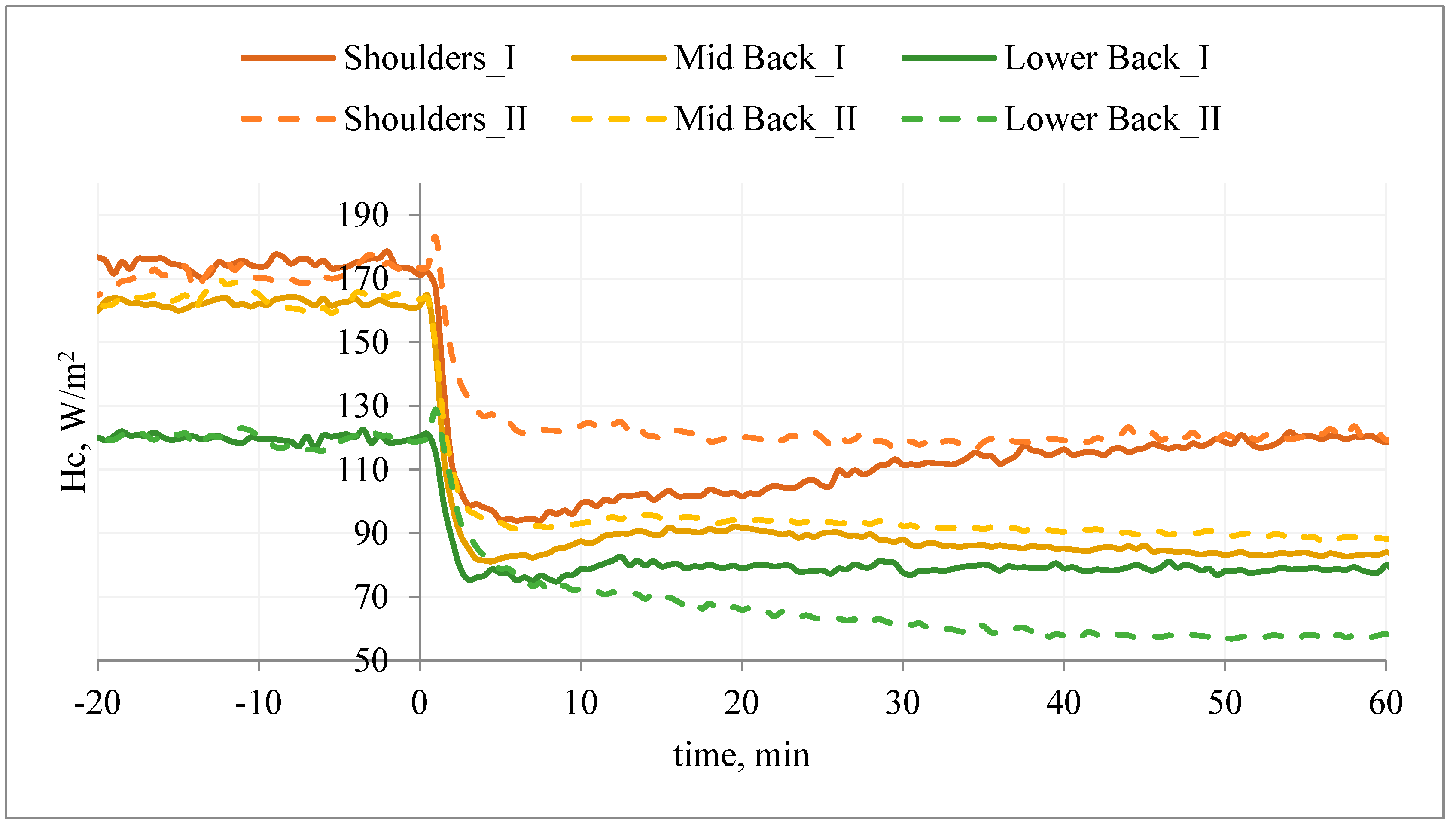
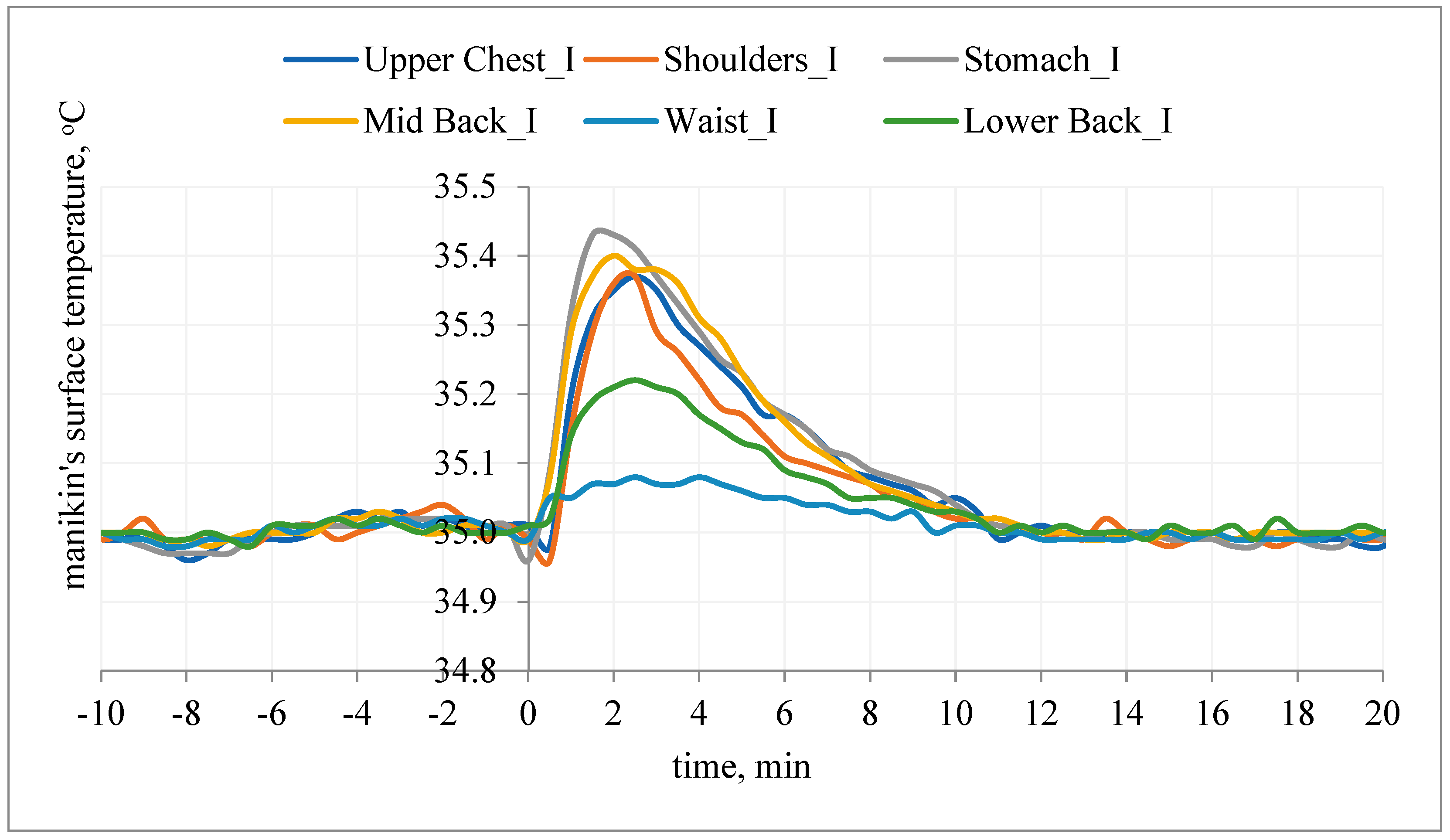
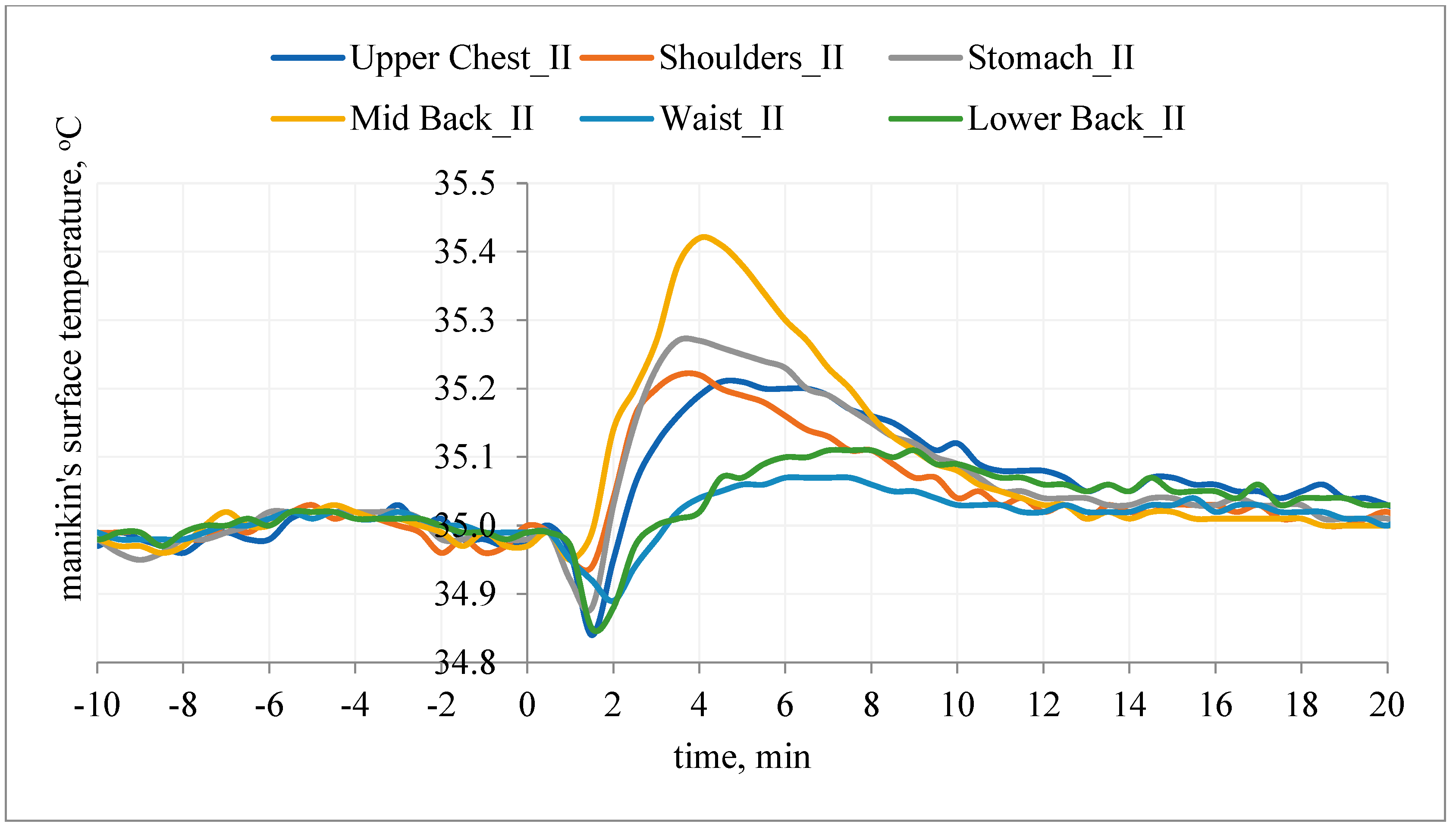
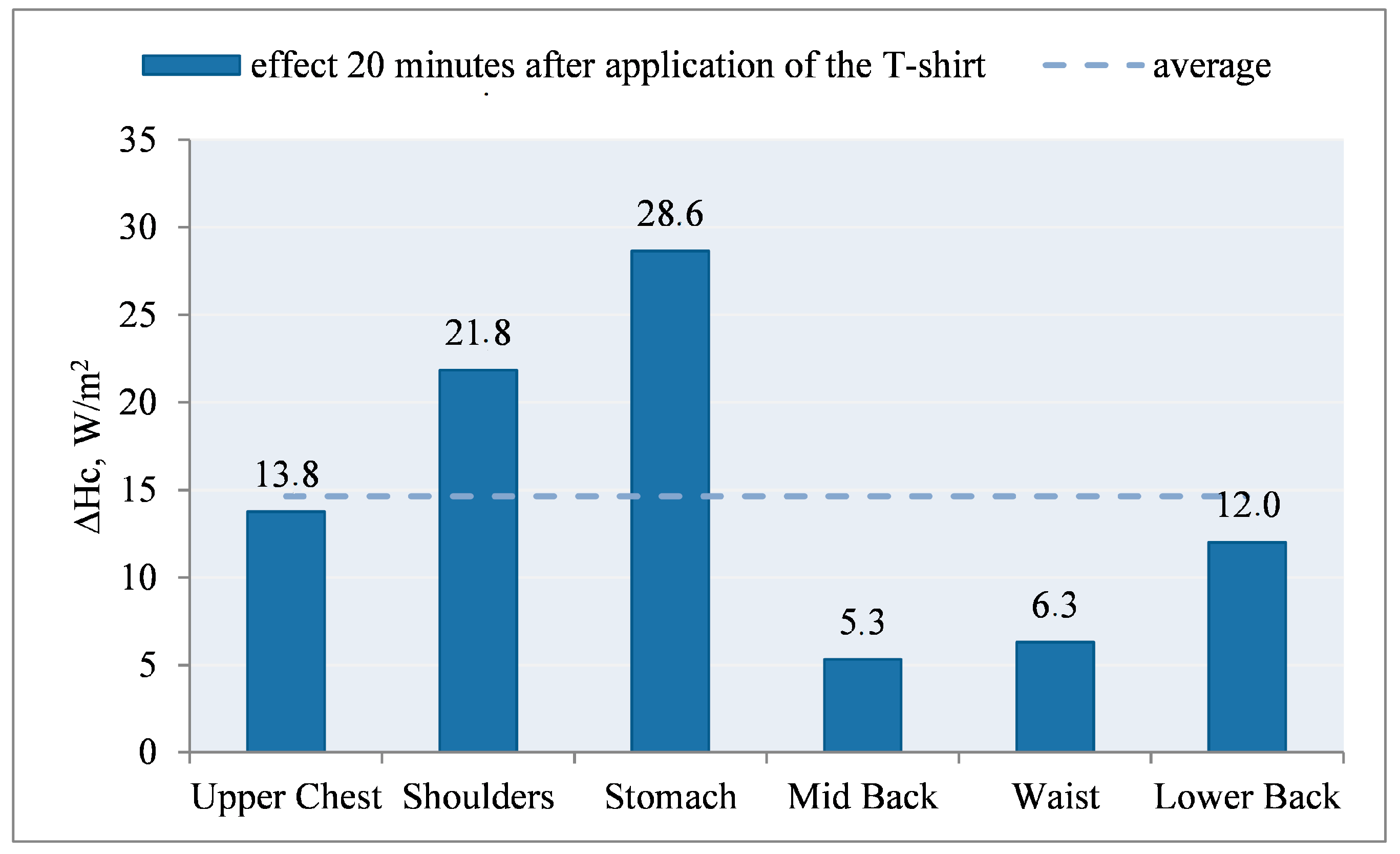



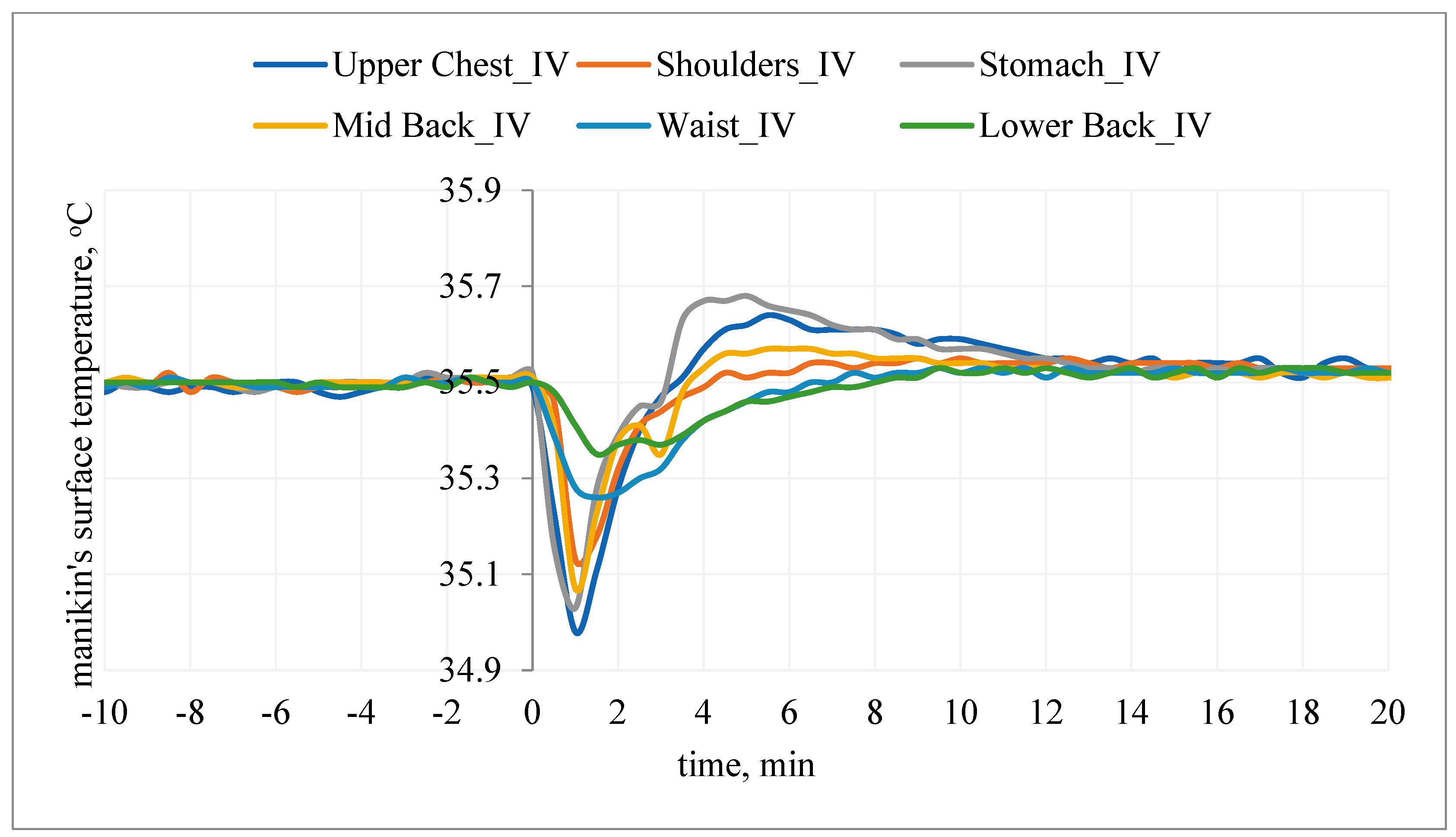

| Variant | Undergarments | Outerwear | Cooling System |
|---|---|---|---|
| I | Undergarments Type A | − without | OFF (without PCM) |
| II | − without | ON (with PCM) | |
| III | + with | OFF (without PCM) | |
| IV | + with | ON (with PCM) |
| Variant I_T-Shirt without PCM | ||
| Before putting on T-shirt | Directly after putting on T-shirt | 10 min after the putting on T-shirt |
 | 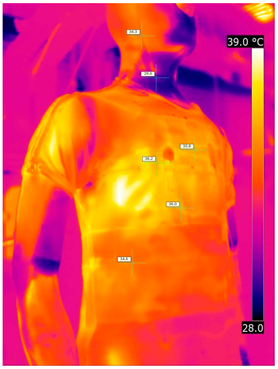 | 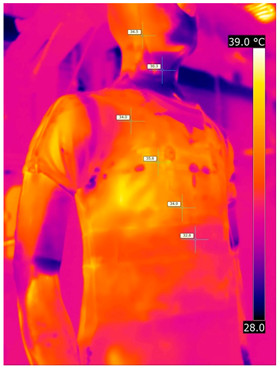 |
| Variant II_ T-Shirt A with PCM | ||
| Before putting on T-shirt | Directly after putting on T-shirt | 10 min after the putting on T-shirt |
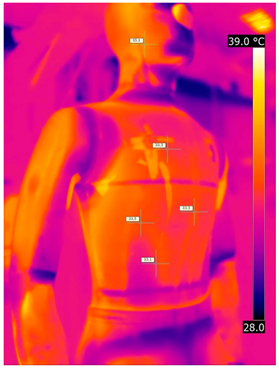 | 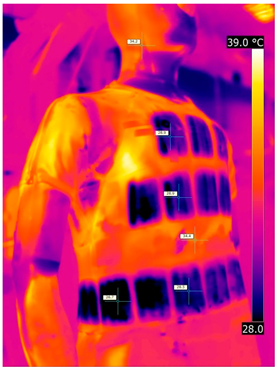 |  |
| Variant I_T-Shirt without PCM | ||
| Before putting on T-shirt | Directly after putting on T-shirt | 10 min after the putting on T-shirt |
 | 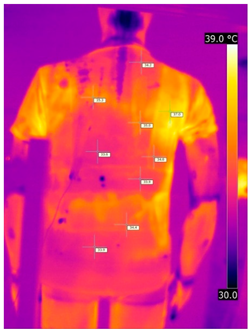 | 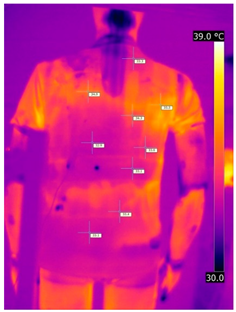 |
| Variant II_T-Shirt A with PCM | ||
| Before putting on T-shirt | Directly after putting on T-shirt | 10 min after the putting on T-shirt |
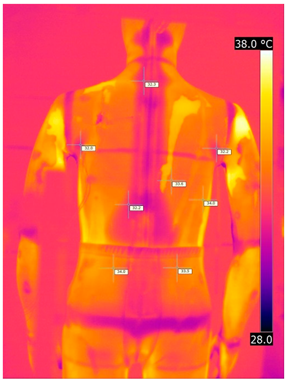 | 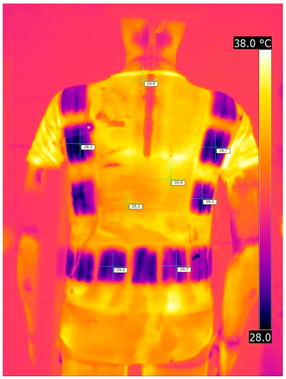 | 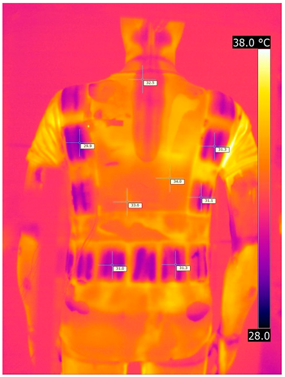 |
| Variant III_ Undergarment A without PCM with Outerwear | ||
| Before putting on T-shirt | Directly after putting on T-shirt | 10 min after the putting on T-shirt |
 |  | 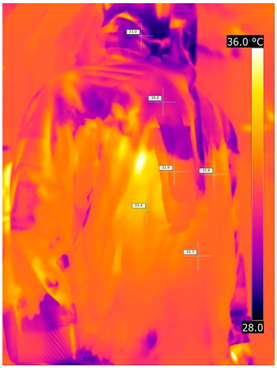 |
| Variant IV_ Undergarment A with PCM with Outerwear | ||
| Before putting on T-shirt | Directly after putting on T-shirt | 10 min after the putting on T-shirt |
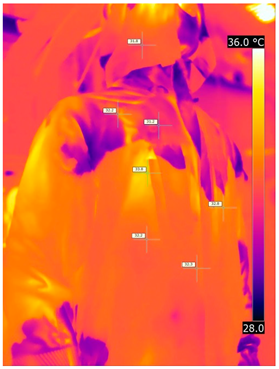 |  | 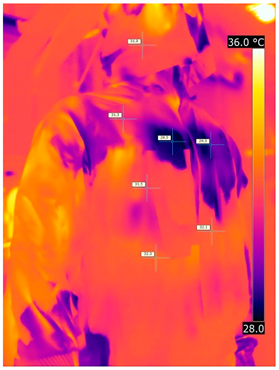 |
| Variant III_ Undergarment A without PCM with Outerwear | ||
| Before putting on T-shirt | Directly after putting on T-shirt | 10 min after the putting on T-shirt |
 | 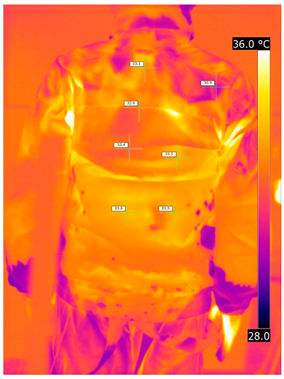 | 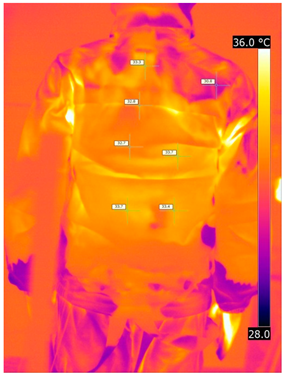 |
| Variant IV_ Undergarment A with PCM with Outerwear | ||
| Before putting on T-shirt | Directly after putting on T-shirt | 10 min after the putting on T-shirt |
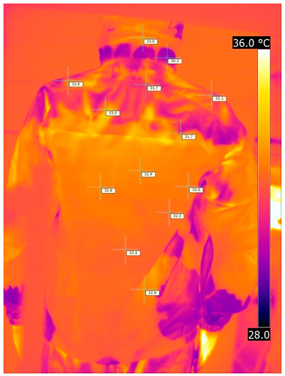 |  | 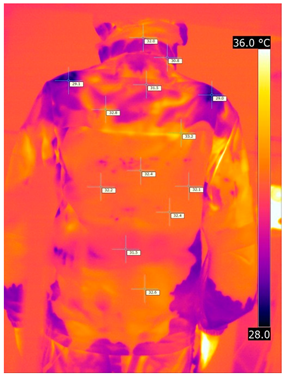 |
Publisher’s Note: MDPI stays neutral with regard to jurisdictional claims in published maps and institutional affiliations. |
© 2022 by the authors. Licensee MDPI, Basel, Switzerland. This article is an open access article distributed under the terms and conditions of the Creative Commons Attribution (CC BY) license (https://creativecommons.org/licenses/by/4.0/).
Share and Cite
Młynarczyk, M.; Bartkowiak, G.; Dąbrowska, A. Cooling Effect of Phase Change Materials Applied in Undergarments of Mine Rescuers in Simulated Utility Conditions on Thermal Manikin. Materials 2022, 15, 1999. https://doi.org/10.3390/ma15061999
Młynarczyk M, Bartkowiak G, Dąbrowska A. Cooling Effect of Phase Change Materials Applied in Undergarments of Mine Rescuers in Simulated Utility Conditions on Thermal Manikin. Materials. 2022; 15(6):1999. https://doi.org/10.3390/ma15061999
Chicago/Turabian StyleMłynarczyk, Magdalena, Grażyna Bartkowiak, and Anna Dąbrowska. 2022. "Cooling Effect of Phase Change Materials Applied in Undergarments of Mine Rescuers in Simulated Utility Conditions on Thermal Manikin" Materials 15, no. 6: 1999. https://doi.org/10.3390/ma15061999








